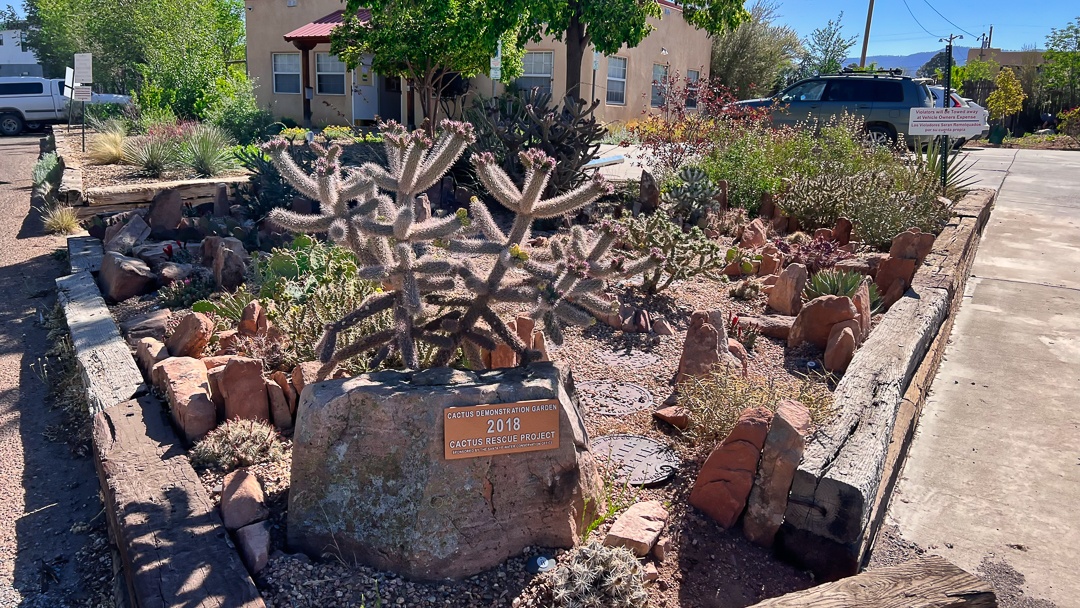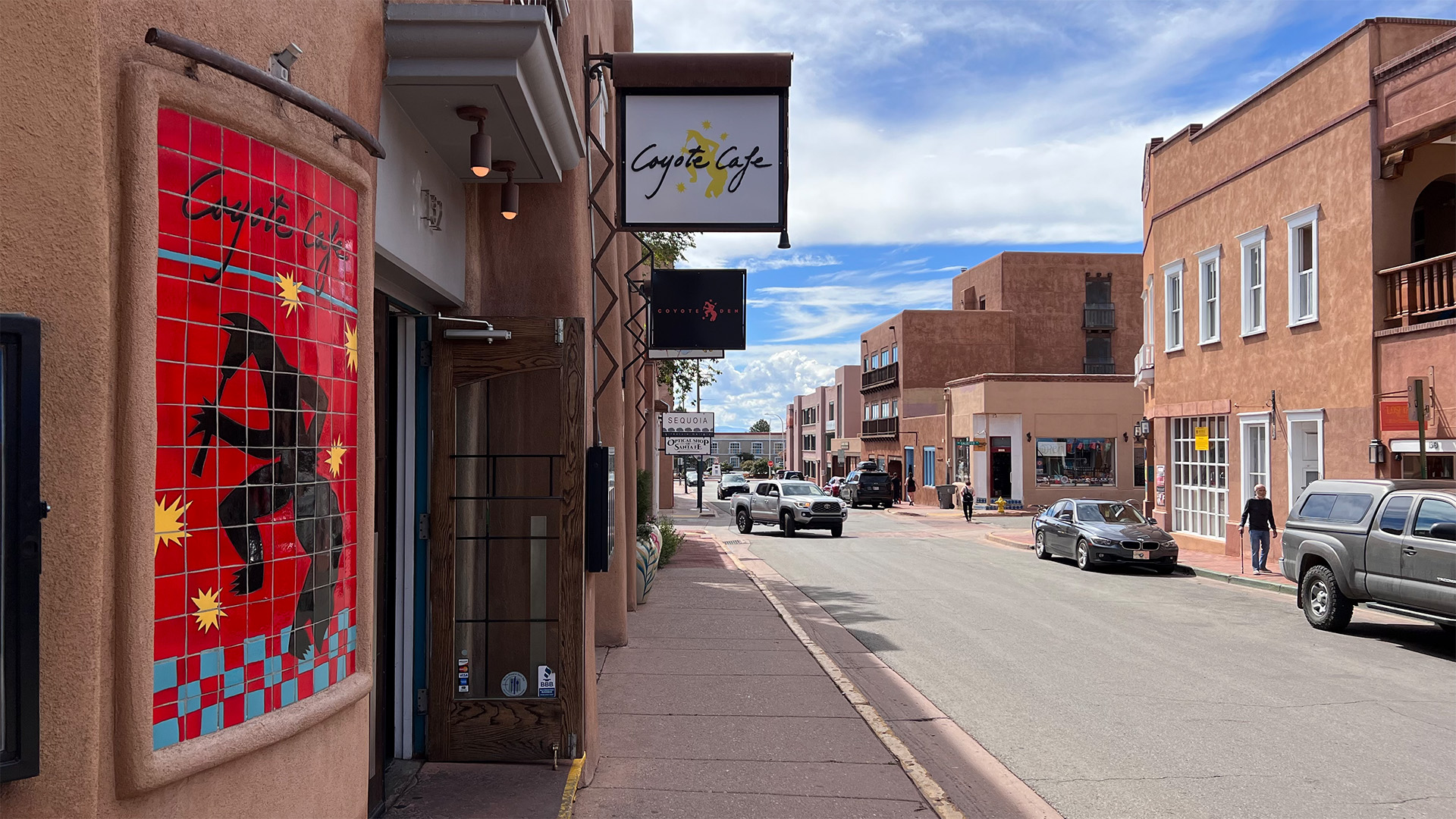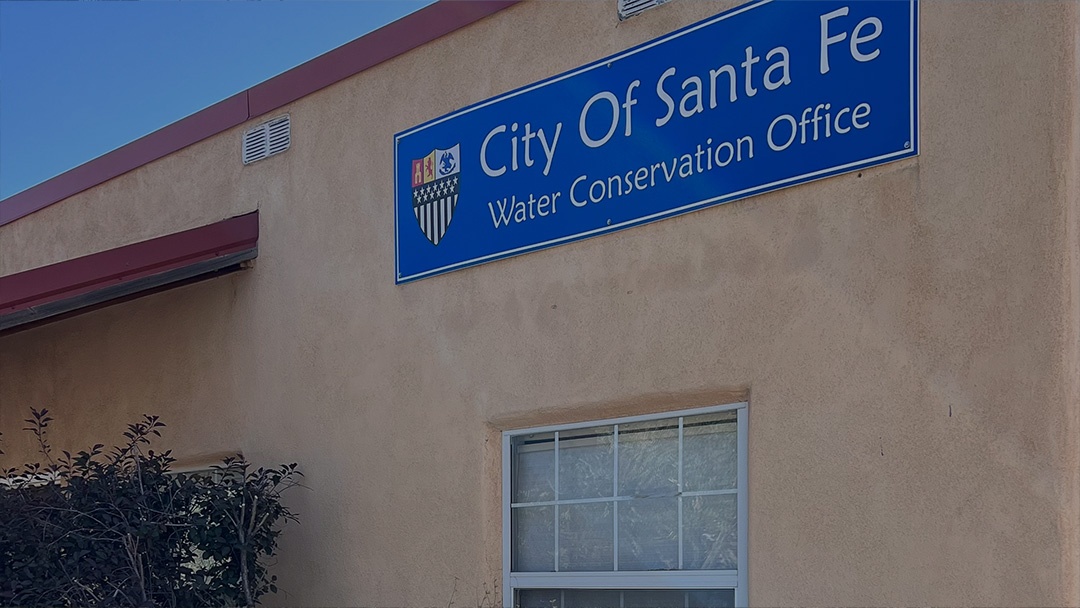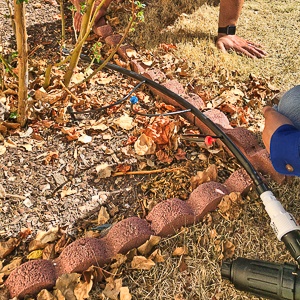Cactus Demonstration Garden

The Water Conservation Office in conjunction with The Cactus Rescue Projectinstalled a beautiful xeric cactus garden in the summer of 2018. Walk through the garden, identify the various cacti using the numbers and descriptions below. We hope you use this reference to enhance your own garden with these waterwise plants. You can also download the list here.
- Claret Cup Hedgehog (Echinocereus coccineus) – Small thick barrels have short to medium spines, Red/orange flowers blooms from mid-May through mid-June. Red fruit. Forms clumps 6-8 inches high byl8 plus wide.
- Claret Cup (Echinocereus triglochidiatus)-The tallest barrels to grow locally. l2H by 12″ wide. Plant forms a large clump quickly. Scarlet flowers in mid-May through June. Blossoms that last for several weeks. Large, juicy fruits.
- Brittle Prickly Pear (Opuntia fragilis)– Low growing (4 inches tall) mats that can be more than a foot in diameter. Yellow or pink flowers appear in late-May.
- Fragilis Hybrid (Opuntia fragilis x polycantha)- Low growing (4 inches tall) mats that can be more than a foot in diameter. Pinkish rose-colored flowers appear in late-May.
- Fendler’s hedgehog (Echinocereus x fendleri)- 3 to 12 inches high, solo or in clumps, with dark pink flowers blooming from mid-May through mid-June. Red fruit.
- Green Pitaya also NM Hedgehog (Echinocereus viridiflorus) – A small cactus growing 2 to 3 inches singular or in clumps with 1″ yellow-green flowers blooming from mid-May (repeat bloomer thru summer).
- Pancake cactus (Mammillaria meiacantba)- Flat but can reach 5″. Rings of white to light pink flowers with dark midstripe. Showy red fruits. Blooms early May.
- Devil’s cholla (Opuntia clavata) – A low, creeping cholla from central New Mexico. White, barbed spines are beautiful but treacherous. 4 inches high by 12 inches plus diameter. Zone 5. Bright yellow flower bloom in late- June.
- Ball Cactus (Coryphantha vivipara/ Escobaria vivpara) – Large 3-4′ diameter balls, mostly solitary/ sometimes clumps, fairly white spines, large hot pink flowers bloom late May (repeat bloomer thur summer).
- ‘Red Gem'(Opuntia basilaris x Opuntia fragilis hybrid) The small, round, 2-3″ wide pads have very short spines. (pads break off easily). Abundant petite, deep pinkish-red flowers in early- June. 4″ high by 18″ wide·.
- PeterPan (Opuntia polyacantha) – A non-flowering, perpetual juvenile form. Snow white, short spines on small pads, l” wide by 3″ long. The tight, carpeting cushion is 3″ high by 24 inches wide.
- Pottsii’s Prickly Pear (Opuntia pottsii)– Small blue-green pads, tubular rooted prickly pear. 3″ high by 12″ wide.
- Santa Fe cholla (Cylindropuntia viridijlora) – An endangered cholla variety found in Santa Fe. Grows 3- 4 feet high and wide with bronze orange to salmon colored flowers blooms mid-June through mid-July.
- Cane Cholla (Cylindropuntia spinosior) – This heavily spined cholla grows to about 3-6 feet high. Magenta flowers blooms late-June through July.
- Klein’s Cholla (Cylindropuntia kleiniae) A sprawling open crowned Cholla from 3 to 6 feet tall and wide. Light pinkish to violet flowers blooms early- July. Orange to red fruit.
- Whipple cholla (Cylindropuntia whipplei) – A wonderful shrubby cactus from Utah with finger-sized stems and lots of spines. Small, chartreuse flowers in late June through July. 36″ high by 60″ wide.
- ‘Snow Leopard’ (Cylindropuntia whipplei)– Shimmering, silvery-white, dense spines make this cholla practically glow in the dark! It will be the most spectacular specimen in your garden. Yellow flowers bloom late June. 36″ high by 60″ wide.
- White Flowering Tree Cbolla (Cylindropuntia imbricata) – This common cholla plant grows to about 3- 6 feet high, but can grow larger. White flowers blooms late-June through mid-July. Yellow “star” fruit.
- Parrot Cholla (Cylindropuntia “Parrot’, – This common looking cholla grows up to 3- 5 feet high and wide. Distinctive golden flowers with red streaks on petals. Blooms late June through July.
- Golden Carpet Beaver Tail (Opuntia aurea )– Spineless with tiny glochids. Bright yellow flowers bloom in early-June and often reblooms in July. 6 inches high by 36 inches wide. Red flowers in May.
- BeaverTail (Opuntla aurea) – Spineless blue-gray pads with tiny glochids. Can grow up lo 2 feet by 2 feet. Hol pink flowers bloom from late May through June.
- Purple Prickly Pear (Opuntia violacea var macocentra) – Long black spines/or spineless on bluish to purplish pads. Large yellow flower/ red inside blooms in June. Large purple/red fruit. Bushy prickly pear grow to 18″ high by 36″ wide.
- Dark Knight Prickly Pear (Opuntia rodantha) – Unlike most prickly pears the Dark Knight’s pad keep the deep purple all year around. Brilliant fuchsia flowers in June on rich purple pads. 10″ high by 48″ wide.
- Snowball Prickly Pear (Opuntia rodantha) – Modest spines and a compact habit. Creamy white near-double flowers in June. 10″ high by 48″ wide.
- Navajo Prickly Pear (Opuntia nicholli) – From Navajo Bridge area AZ. Uniformly cloaked in 1 inch long white spines. Hot Pink flowers in early June. 8″ high by 48″ wide.
- Coombs Winterglow (Opuntia aurea) – Spineless purplish pads with tiny glochids. Can grow up to 3 feet by 3 feet. Hot pink flowers bloom from late May through June.
- BeaverTail Dazzeler (Opuntia basilaris) – Spineless blue-gray pads with tiny glochids. Can grow up to 2 feet by 2 feet. Flashy pinkish red flowers bloom from late May through June.
- Western Prickly Pear (Opuntia macrorhiza) – Dark green pads appear to lie flat on ground. Tubular rooted prickly pear. 3″ high by 24″ wide. Yellow flowers in May.
- Plains Prickly Pear (Opuntia polyacantha) – Grows in low (16 inch) mats that may spread 5 to 6 feet in width. Yellow flowers blooms mid-May through June.
- Clorado Plains Prickly Pear (Opuntia polyacantha v. colorado) – Grows in low (16 inch) mats that may spread 5 to 6 feet in width. Pink flowers blooms late May through June. Since flower color in both Opuntia phaeacantha and Opuntia polyacantha ranges from shades of yellow to copper-yellow to pink to magenta, flower color cannot be used to distinguish between the two species. The spines and glochids of the fruit, seed texture, spine shape, and spine spacing are key distinguishing characteristics.
- Texas Prickly Pear (Opuntia lindheimeri)– May grow up to 3 feet high and 5 feet wide. Flowers are yellow to yellow-orange bloom in mid-June. Large purple fruits.
- Christmas Cholla (Cylindropuntia leptocaulis) – small Pencil cholla can grow to 4 feet high. Yellow flowers in late June turn to red fruits in fall to look like “Christmas balls”.
For more information go to: www.cactusrescueproject.info






